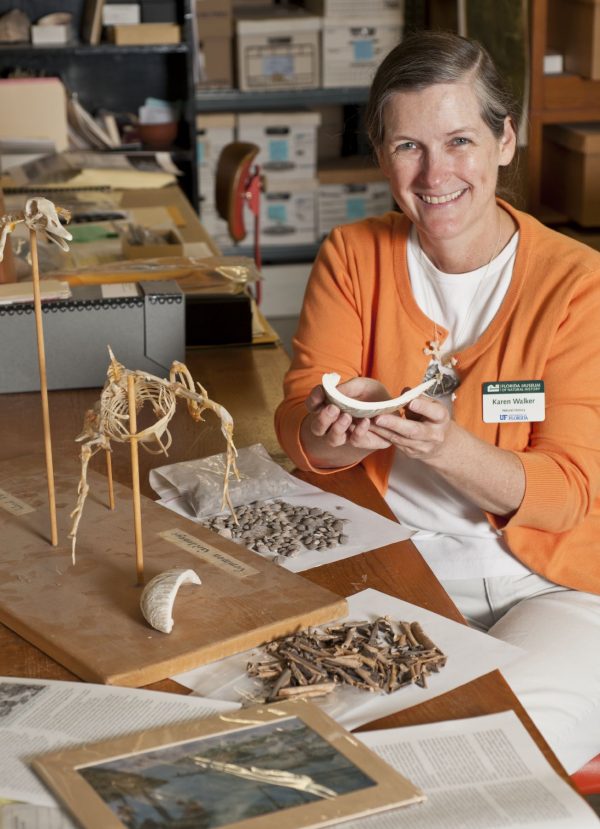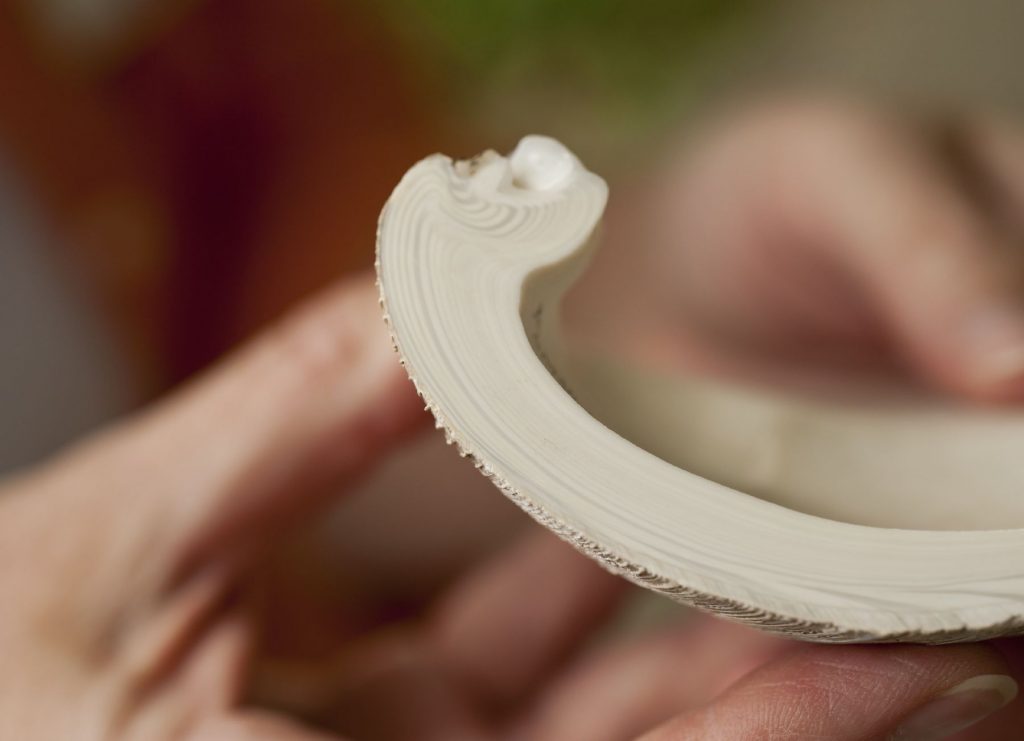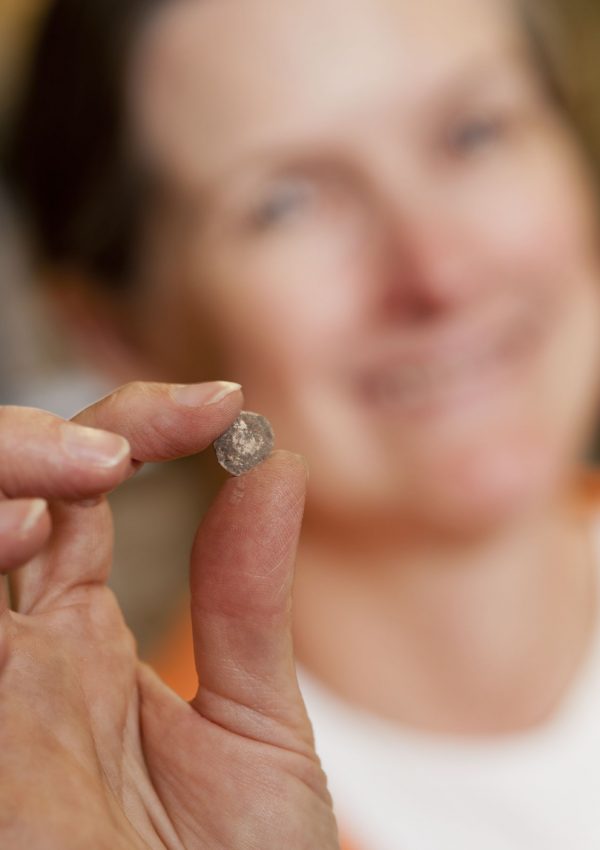
Florida Museum photo by Kristen Grace
The mysterious appearance of numerous ancient duck bones dating to the sixth century at the Pineland archaeological site on Pine Island in southwest Florida was the first clue to one Museum researcher’s new understanding of the state’s environmental history.
Karen Walker, assistant scientist of south Florida archaeology at the Florida Museum of Natural History, knew it was odd to find so many bones since the winter migratory range for ducks normally extends to the northern Gulf Coast, but not as far as south Florida. This suggested a climate cooler than today’s.
Other clues from the same period include a change in residents’ firewood from black mangrove to pine, suggesting a drier landscape, and a reduction in the number of fish bones, indicating people were eating less fish.
Using isotopic information from southern quahog clam shells and marine catfish otoliths (ear bones) collected at the site, Walker and co-authors Ting Wang and Donna Surge of the University of North Carolina at Chapel Hill confirmed cooler and drier weather characterized southwest Florida from about A.D. 500 to 850. This time span correlates with a wide-scale climate episode known as the Vandal Minimum, which is also associated with lower sea levels.
“When we started out, we thought, ‘Well, why wouldn’t you want it to be cooler in south Florida, it must have been nice,’ ” said Walker, who co-authored the study published online April 11, 2011, in The Holocene. “But in the end, I realized it’s all about fish – if you lose your water, you lose your fish.”
Because Pine Island is low-lying and the adjacent sound is shallow, they are particularly sensitive to climate change. During the Vandal Minimum, lower sea levels likely forced the Calusa Indians, who inhabited Pineland in the first century, to temporarily abandon the site as early as A.D. 750, Walker said.
“They returned when sea levels rose again in the late ninth century,” Walker said. “These socio-politically complex Calusa people continued to live there until about 1700, fishing and shellfishing the nearby shallow estuarine waters.”
The Vandal Minimum is the least-studied of the four named climate episodes of the past 2,000 years. Preceding today’s warming trend, the episodes – from most recent to earliest – are the Little Ice Age, the Medieval Warm Period, the Vandal Minimum and the Roman Warm Period.

Florida Museum photo by Kristen Grace
“When we excavated at Pineland, we worked in areas that represented all these different time periods,” Walker said. “We found that short-term climate changes and especially sea level changes really impacted what was going on at this place and how the people were dealing with it.”
Changes in home locations, use of firewood and available foods all seem to reflect adjustments to environmental changes. The evidence at Pineland also shows at least three of the named episodes were not uniformly cool or warm, with low or high waters.
“For example, there seems to have been at least one brief, slightly warmer, wetter, multi-decadal sub-episode during the Vandal Minimum at Pineland, as indicated by the firewood, food and isotopic data,” Walker said.
Similar climate patterns occurred in regions around the greater North Atlantic Ocean, including Western Europe and Mexico. The cooler climate in Europe coincided with crop failures and the Vandal invasion of Europe, factors leading to the fall of the Roman Empire. In Mexico, a long series of droughts likely played a role in the Mayan “collapse.”

Florida Museum photo by Kristen Grace
“There is practical value in seeing how climate variation in the past impacted people and how those people responded,” said Fred Andrus, associate professor in the department of geological sciences at the University of Alabama. “While it is useful climatologically to speak of global-scale change over long periods of time as is typical in paleoclimate reconstructions, people in the past usually had economies based on their local environment and change over short periods would have had large impacts.”
Walker, Wang and Surge are now researching specimens from the latter part of the Roman Warm Period. Archaeological evidence from that time, A.D. 1 to 500, suggests inhabitants dealt with three sub-episodes of warming and high waters, as well as at least one hurricane, Walker said.
“As the public becomes increasingly aware of global warming patterns today, this research is important for understanding the adaptations humans need to make during climate change,” she said. “Coastal Florida, in general, presents a very flat landscape and we can look at Pineland’s history and essentially see how things are going to be impacted in the next 100 years with rising sea levels.”
The Florida Museum manages the Randell Research Center at Pineland, where visitors may learn about the Calusa people and walk the Calusa Heritage Trail, a tour of their history on the island.
“We frequently are asked ‘Well if climate always changed in the past, then why is today’s change such a big deal?’ And we hear, ‘Today’s warming can’t be related to human activity because climate changed in the past without the presence of humans,'” Walker said. “So I explain that there are multiple causes for climate change, humans being only a more recent cause. Also, humans likely contributed to some historical changes. For example, expansive areas of forest were burned during the Roman Warm Period, resulting in a warmed atmosphere. I then point out that it is no coincidence that the current warming trend started with the beginning of the Industrial Revolution about 1850, bringing us out of the Little Ice Age.”
The Pineland project research is supported by the National Science Foundation’s Paleoclimate Program.
Learn more about the South Florida Archaeology & Ethnography Collection at the Florida Museum.